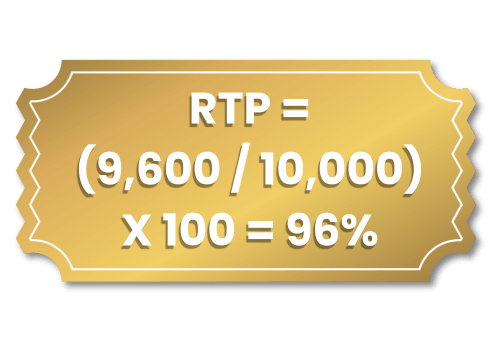When diving into online casinos, grasping the concept of Return To Player (RTP) is essential for gauging your winning prospects. Whether you’re a novice or a seasoned player, comprehension of RTP can significantly shape your game plan and potential earnings.
Join us in this blog as we delve into the essence of RTP, the methodology behind its calculation, and its effects on the overall gaming journey.

What is Return To Player (RTP)?
Return To Player, commonly known as RTP, signifies the proportion of total bets a game reimburses to players over a period. For instance, in a game with 96% RTP, AU$96 is returned for every AU$100 wagered, leaving a 4% margin for the house.
The computation of RTP occurs over an extended duration, often involving millions of spins or game sessions. While RTP offers a broad overview, immediate outcomes can vary greatly.
How is RTP Calculated?

RTP = (Sum Returned to Players / Sum Wagered) x 100
Consider a scenario with AU$10,000 wagered and AU$9,600 returned to players; the RTP calculation would be:
Game developers establish RTP as a constant figure, unaffected by betting volumes or player participation.
Why RTP Matters to Players
Familiarity with RTP aids in making wiser choices about which games to engage with. A higher RTP implies a game returns more funds, appealing to those looking to better their odds.
Nevertheless, it’s crucial to note that RTP doesn’t promise how much one might win in a single game session. Being a statistical figure derived over time, individual sessions can show unpredictable results, where luck plays a pivotal role.
RTP Versus Volatility: Understanding Their Distinct Roles
While RTP is a key consideration in game selection, it’s not the sole factor. Volatility, also known as variance, is another significant aspect, influencing risk levels and payout tendencies.
- Low Volatility : Games with low variance ensure smaller but more frequent wins, suitable for those who prefer consistent play without major risks.
- High Volatility : Conversely, high volatility games can produce larger wins but are less frequent, suited for thrill-seekers willing to gamble on bigger rewards.
Assessing a game’s risk and reward structure assists in aligning it with personal preferences and risk tolerance.
How to Find the RTP of a Game
If you’re curious about a game’s RTP before playing, there are several avenues to find this information:
Game Information or Paytable
Games like Online Pokies present RTP details openly. This data may be found in the game’s paytable or rules section.
RTP, an acronym for Return to Player, indicates the percentage of bets returned over time. Players can leverage this data to make better-informed gaming choices. Look for an “info” button or the game’s menu for this insight.
Casino Website
Certain online casinos provide RTP information directly on their websites, either on the main game page or within dedicated information sections.
Third-Party Review Sites
Numerous websites reviewing casino games offer RTP insights, acting as a valuable resource for comparing RTPs prior to investing time and funds into a game.
RTP in Different Game Types
RTP extends across all online casino game formats, not only pokies. Here’s a glimpse into its application among some favorite categories:

Online Pokies
Online Pokie games usually feature RTP ranges from 90% to 98%, allowing players the flexibility to select based on desired risk levels.

Table Games
Classics like Blackjack, Roulette, and Baccarat each have their RTP figures. European Roulette runs at approximately 97.3% RTP, while some Blackjack variations can hit 99.5%.

Video Poker
Video poker games often boast exceedingly high RTPs, reaching over 99% if approached with the right strategy. Top-paying options include Joker Poker (100.64%) or Deuces Wild (100.76%).

Live Casino Games
Even live dealer games come with RTP figures, although they may differ depending on the game’s specific rules and variations. European or French Roulette tables are recommended for superior win ratios.
How RTP Affects Your Gameplay
RTP importantly affects your gaming experience by enhancing value through higher returns on wagered amounts. However, gaining a firm understanding of both RTP and game variance, along with self-awareness of your playstyle, is key for an optimal experience.
For prolonged play, opt for high RTP and low volatility games. This option allows for frequent wins, adding enjoyment to your gaming. If the thrill of hefty wins attracts you, a high-volatility and lower RTP game might better suit your tastes.
Common Myths About RTP
RTP misconceptions abound, leading to potential misunderstandings. Here are some misunderstandings to be aware of:
- A high RTP ensures wins. RTP represents a long-term average, not a promise for a particular playing session.
- RTP varies by time or player count. Set by developers, RTP remains constant and isn’t influenced by outside conditions.
- Identical RTP games are the same. Although having the same RTP, games can differ in gameplay experience due to their volatility and features.
Leveraging Win Rates
Return To Player (RTP) forms a cornerstone of online casino knowledge. It indicates potential winnings in the long term, guiding players to select games intelligently. However, remember RTP is merely part of the bigger picture—considering volatility, personal gaming approaches, and risk appetite assists with choice.
A greater understanding of RTP and its effect on win rates enriches online gaming enjoyment and profits.











